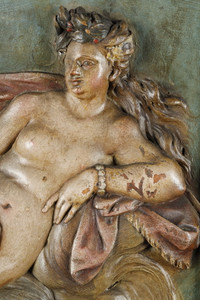



















Suite of four basswood panels carved in bas-relief and polychromed
Rare suite of four bas-relief carved and polychromed limewood panels depicting mythological scenes, European work from the first half of the 18th century. The panels depict various mythological scenes related to the goddess Venus (Aphrodite). The polychromy offers beautiful highlights of color, notably red and yellow, which serve the narrative (the sun's golden rays, the flames of the hearth, the golden ornaments on the shield...). Circa: 1730.
The four scenes depicted evoke episodes
1. A group of naked female figures, floating in the air in a cloud, brandishing bundles of wood, chase a man who bends under their domination. The attributes of Venus can be seen leading this offensive.
2. Venus can be recognized by the veil she holds high above her head at the end of her arm. She is accompanied by Cupid, who has just shot a love arrow at a man kneeling on the ground. The long-haired, bearded man is Vulcan/Hephaestus, Venus's husband, and at his feet he wears armor and blacksmith's pliers. The iconography is faithful to Virgil's Aeneid, in the episode where Venus asks Vulcan to forge prestigious weapons for her son, Aeneas, who is about to go and found Rome.
3. Venus again floating in the air, this time semi-recumbent in a sheet. She is accompanied by Lucifer, the angel to her left brandishing a flame. At her feet, a warrior, one knee on the ground, spear in hand, gazing in the direction of the Goddess, indicates a panoply of weapons (a shield, a helmet adorned with two feathers, a spear, a sword). In another passage from the Aeneid, Venus appears shining on the clouds, bringing the weapons promised to her son.
4. In this scene, we find Vulcan in his forge; on the left, a lit hearth, from which we can see embers and flames, used to heat the blacksmith's tools, on the right an anvil on which Vulcan is leaning, holding a hammer, strewn on the ground a breastplate, arrows and pliers used to clamp the pieces to be worked. Vulcan, his right arm raised to the sky, addresses the sun, which is wearing a face - the personified sun god Helios. The artist is recounting a passage from Homer's Odyssey.
Dimensions: excluding frame: 74 x 35 cm.
Dim: W: 47cm, D: 4cm, H: 86cm.
Dim: W: 18,5in, D: 1,6in, H: 33,9in.
Condition report: Good condition, some cracks to be noted























